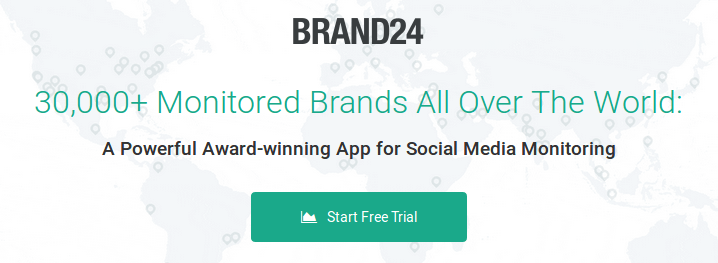How Mercedes-Benz Uses Social Media – Case Study
What is the first thing that comes to your mind when you hear the name of Mercedes-Benz? A fashion week, a line of perfumes or perhaps a luxurious car? Chances are that, even though all of these answers are correct, you would most probably go for the last one.
Mercedes-Benz. From a marketing perspective, one of the most recognized and prestigious cars on the planet associated with highly reputable German precision and premium craftsmanship. From a formal perspective, a division of a multinational corporation Daimler AG, a global automobile manufacturer of luxury vehicles, buses, coaches, trucks, yachts, and, don’t be surprised, a longstanding partner of the fashion industry with more than 30 fashion weeks organized and sponsored worldwide and, indeed, a fragrance line launched in 2011. With the remarkable brand heritage dating back to 1927, when the first Mercedes-Benz vehicle was officially introduced to the public, the German automobile giant remains a top ranking car manufacturer in the world.
Let’s have a closer look at Mercedes-Benz social media presence to find out if it matches up to their smart, forward-looking and meticulously crafted vehicles. Before we do that, however, have a glance at a short outline of the brand’s unique marketing approach that nurtures its excellent market results.
Marketing Segmentation
Mercedes-Benz is a premium brand, however, more or less since 2011 the company started to use a thoroughly planned and perfectly executed market segmentation alongside skilfully designed digital marking to reach, influence and engage with a younger less-affluent consumer base. And there would be nothing particularly remarkable about this, if not the fact that they have actually managed to achieve this goal without losing anything from the band’s prestige and its iconic reputation.
The car company began the process of marketing segmentation by creating a so-called “Generation Benz”, that was an online community of approximately 200 to 250 people aged between 20 and 39 who provided consulting to the Mercedes-Benz marketing team about buyer habits and preferences in this particular demographic group.
This clever move of incorporating social listening into the process of developing marketing strategy has enabled the German car company to get priceless information about who their customer really was and, based on this insight, to create a product – more affordable Mercedes-Benz CLA-Class – and correlated social marketing campaigns that perfectly fitted the selected market segment of a younger consumer demographic.
How exactly does the iconic German car brand perform on social media? What techniques and tools do they use? How do they employ social media to gain a younger customer while remaining true to the brand prestigious heritage? Fasten your seat belts, we are going to explore it all just now.
How Mercedes-Benz Uses Social Media
Mercedes-Benz has the greatest following on Facebook where the brand’s principal global account gathers more than 20 million followers. Instead of geo-targeting for this Fan Page, however, they run separate regional accounts dedicated to particular countries, car classes as well as business units like Mercedes-Benz Museum and sponsored events including Mercedes-Benz Fashion Week Australia to name one.
Content & Engagement
Their main Facebook account looks very well planned and organized as they maintain their presence on it by posting regularly 2-3 times a day (German precision indeed).
The content they share is very much visually driven. It is made up of mainly images and videos, including live streaming videos. They keep it fresh and engaging by publishing a diverse range of information – from car racing-related news, high-quality photographs featuring their cars in action, up to status updates recalling Mercedes-Benz contribution into legendary automobile inventions to reinforce the brand’s heritage value.
Occasionally they share a promotional video or photo either to a campaign they are running or a new car model that is currently being produced. From time to time they also cross-promote content from other regional pages, like here from the US one:
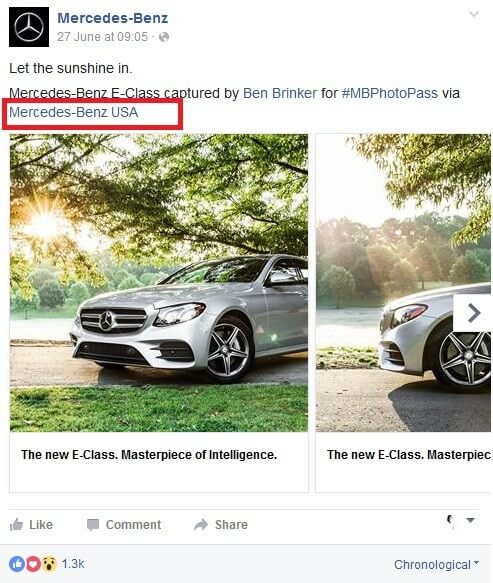
The content they post is quite often linked back to the corporate website promoting recent blog posts that incorporate stunning, high quality, photographs presenting not only the car itself but above all the lifestyle it represents. They use powerful storytelling by presenting customer’s stories as a way to further strengthen brand’s message and to help other customers to identify themselves with their products.
They have recently posted a story of a DYNAFIT-manager Benedikt Böhmand and his family who tested the Mercedes-Benz Marco Polo on a trip to Mont Blanc.
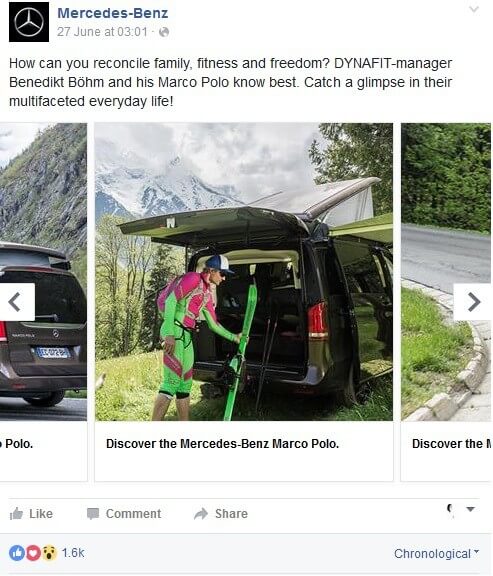
Their videos regularly receive hundreds of thousands of views, likes and comments, which can be partly explained by the fact that they often reinforce the message by featuring and tagging in their content trending and popular influencers such as car racing stars including Pascal Wehrlein, Nico Rosberg and, Jan Seyffarth to name a few.
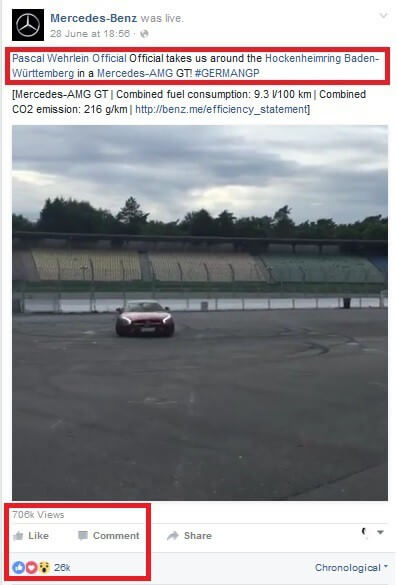
Mercedes-Benz have developed branded hashtags shared between social media platforms, such as #MBPhotoPass where they allow social influencers, journalists, and team members to curate fresh and organic user-generated content for their accounts.
The innovative #MBPhotoPass initiative have been started by Mercedes-Benz USA in 2014, initially only for their Instagram account, and is still being used across all their main social media platforms to the delight of the fans who appreciate brand’s authentic narratives and perhaps also hope to get #MBPhotoPass themselves.
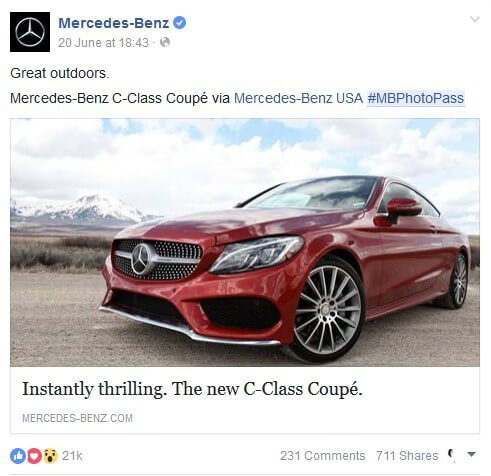
[mid_banner]
As to building engagement with their fans, Mercedes-Benz don’t really use direct questions on Facebook and their tone of voice is kept rather formal and informative. In spite of this, however, the number of likes and views they get, particularly for the video content, is impressive. This could suggest, that the content they share on Facebook is of great value to their target audience.
Even though the majority of the feedback that Mercedes-Benz receive from their followers on Facebook is positive, they don’t tend to respond to the comments and majority of social conversations and interactions underneath the Facebook posts are between the followers themselves.
On Twitter, Mercedes-Benz runs multiple accounts, however, the German and the American accounts take the lead here with 1.6 million (@MercedesBenz) and 582K (@MBUSA) followers, respectively. Even though they have a smaller community on Twitter than on Facebook, they are much more active on this platform by posting regularly an average of 6-8 times per day.
Content & Engagement
On the @MercedesBenz, all tweets are made up of images and videos. When they share photographs, they often share the whole album instead of just a single shot. The content they post on Twitter isn’t exclusive to this platform. They cross-promote publications between Facebook, YouTube, and the corporate website as well as between other Mercedes-Benz regional Twitter accounts.
What they share on Twitter is similar to Facebook and includes a combination of car-racing news, inspiring lifestyle images of their cars in action as well as some dose of historical news on the Mercedes- Benz vehicles evolution. This goes in line with the global strategy approach to keep the brand image relevant for the younger and social media savvy audience but still reinforce its prestige that comes with the heritage.
The tone of voice that Mercedes-Benz use on Twitter is less formal than on Facebook. It reveals more of the brand’s human face and
Mercedes-Benz inject a lot of user-generated photographs into their Twitter feed and they have developed a unique way of tagging their contributors by adding a camera icon to the posts:
On a very rare occasion, they retweet content from other brands and users and only if it refers direly to Mercedes-Benz. This may include tweets from influencers, official brand ambassadors, and team members who posts about the company.
As to engagement with their fans, they are much more active on Twitter than on Facebook. They interact with tweets from followers when they are a customer inquiry, but also reply regularly to random comments and questions. Again here, the tone of voice is less formal and more inviting. They often use emoji in their replies too.
Instagram is for Mercedes-Benz the second most important social media platform as to the number of followers and the first one as to the level of engagement they get from these 5.7 million followers at their global account and 1.1 million fans on their US account. The Mercedes-Benz and the Mercedes-Benz USA, in particular, take quite a different approach to Instagram when compared to other main social media networks. While Facebook and Twitter are more like direct-response channels, Instagram is intended to serve mainly as a branding platform.
Content & Engagement
On global account, Mercedes-Benz is almost as active as on Twitter. They tend to post an average of 5-7 times per day and get an impressive level of engagement from their fans – regularly something in between 50K and 100K likes per post.
Their presence on Instagram looks like the result of a very well planned and precisely executed strategy. They put great effort in producing dedicated and unique for this platform content. Mark Aikman, general manager of marketing services at Mercedes-Benz USA, stresses this fact out: “It’s important to create original content and not recycle images and videos”. And he adds: “Success is built on the quality of aesthetics. Imagery is everything on Instagram.”
The quality of Mercedes-Benz photography on Instagram is indeed very high and they use various locations and sceneries for their cars to create brand’s image that is appealing to the customers across the globe.
They keep the Instagram feed fresh by injecting a lot of user-generated content from social influencers including car racing stars, bloggers, and photographers as well any other users. They encourage everybody to share Mercedes-Benz shots by adding a branded hashtag #mbfanphoto in the bio description:

On Instagram, Mercedes-Benz is known for innovative campaigns. For example for #MBPhotoPass, the @MBUSA handed over the control of the account to Kelly Lund a globetrotter and a social influencer who travels the world with his dog – extremely popular Loki the Wolfdog – and documents their adventures on social. Lund’s posts shared between both the Mercedes’ and Loki’s accounts generated hundreds of thousands of likes and shares.
Mercedes-Benz marketing strategy on Instagram has nothing to do with direct sales. It is all about visually compelling content and powerful cars stories written mostly by their followers themselves.
Conclusions
Mercedes-Benz know how to get the most out of social media. What to us looks like an effortless practice of simply sharing nice images and videos of their cars, in fact, is a very well planned and precisely executed strategy. Their social media success is rooted in social listening. They make an effort to listen to their customers to know their “likes” and “dislike” first before they craft a marketing message that perfectly fits that particular target group.
Their social media marking is taken to perfection not only because they know their audience so well but also because they perfectly understand specific nature of each of the social media channels.They change and adopt the tone of voice between the platforms to engage their followers and generate more of social conversations. On Twitter, they have perfected the use of trending hashtags to further expand the reach beyond the followers base. On Instagram, they mastered the practice of injecting the feed with fresh organic and powerful visual content from social influencers. On Facebook, their videos, often times live streamed, reach phenomenal level of likes and views, because they learned to produce content that fits the audience’s needs.
There is still some room for improvement, for example as to the engagement with fans on Facebook, but on general, Mercedes-Benz social media presence that is all about “compelling content and telling powerful stories while meeting consumers halfway” as Aikman said, proves to be successful and in this sense it does match up with the excellence-driven products they sell.
Top Reads
Brand Monitoring: Tools & Guide for 2026
Brand Awareness Strategy [The Ultimate Guide for 2026]
The Best AI Hashtag Tracker and Other Hashtag Tracking Tools [2026]
Social Media Reach: How to Measure & Improve It in 2026?
X (Twitter) Analytics Tools: The 10 Best to Try in 2026
Sentiment Analysis: What is it & Why do You Need it in 2026?
Share of Voice: Definition, Calculation, Tools [2026 Guide]
Brand Reputation Management: 6 Expert Tips for 2026
A Complete Guide to AI Social Media Analysis [2025]
How to See How Many Times a Hashtag Was Used on X (Twitter)
Start Social Listening!
Get the Brand24 trial and start social listening like a PRO.
